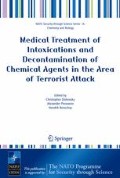Abstract
Early indication and identification of unknown chemical and biological agents play the leading role in the system of countermeasures on liquidation and minimization of the connatural, technogenic and deliberate extreme situations. These necessitate the use of the special laboratory chemical/toxicological, microbiologic, immunological methods of investigation using special hi-tech equipment and specialized laboratories. It is necessary from several hours up to several days for an integrated analysis. Development and introduction of new and simple methods of rapid indication are actual in present. We have proposed method of nonspecific indication of toxic pollutions possible at the various situations including leakages of toxic materials during production of the ordinary chemical compoiuiua and their hit into the objects of the environment, water and food, and also owing to the disasters and deliberate use of chemicals as agents of terrorism. As the ground of this method is the Colpoda steinii (Infuzoria Family) dry culture application, actuary used for the ecologic/toxicological external environment investigations. This method has been applied earlier for an food toxicity evaluation in animal husbandry industries. We have developed the “know-how” for the diagnostic test-system (culture Colpoda steinii) and started production in the Ukraine (GOST 13496.7–97). Method is based on studying of various parentage toxic materials, including chemical compounds, influence on alive biological objects at the level of the integrated organism. Toxicity of the contaminated objects determine by their influence on motility and vital activity of the Colpoda steinii culture. Time from the beginning of the tested probes (water, various surfaces washouts, suspension and solutions of a food products, etc.) influence is the criterion of the toxicity definition. Probes at which addition drop of various degree motility or even colaps of all culture is observed, count as contaminated. Probes with use of which the Colpoda steinii culture destruction comes within 10 minutes of observation consider highly toxic, during till 3 hours - slightly toxic and if in 3 hours of all culture remains mobile - nontoxic. Method is simple in use, allows to receive confirmation of the pollution and estimate preliminary contamination degree in a short time (from 10 minutes till 3 hours) in the inveronment without use of special expensive equipment. The prelimenary estimation can be made before reception of the conclusion about character of the toxic agent and its identification, and the first clinical signs of a lesion. Besides, this method allows to reveal presence residual polutions and to estimate efficacyy of the carried out decontamination.
Access this chapter
Tax calculation will be finalised at checkout
Purchases are for personal use only
Preview
Unable to display preview. Download preview PDF.
REFERENCES
Cairns, J.,Jr. Myths impeding the utilization of infusoria in ecotoxicological toxicity testing / Infusoria in bioassays, Saint Petersburg, 1998.PP.11–21.
Cairns, J.,Jr. Environmental monitoring for sustainable use of the planet / Population and Environment, 1997, v. 18, # 5,PP. 463–471.
Bakaeva E. N. The reasons for usage of unicellular in biotesting / Infusoria in bioassays, Saint Petersburg, 1998.PP.26–27
Vinokhodov D.O., Vinokhodov V.O. Colpoda steinii as a test organism / Infusoria in bioassays, Saint Petersburg, 1998.PP.85–87.
Vinokhodov D.O. Toxicological studies fodders with infusoria using / Saint Petersburg, 1995, 80 p.
G.F.Biloklitska, M.A.Novikova, M.A.Volik, L.I.Pozdnyakova. Test-system for the organism physiologic status evaluation in stomatology by EKB and KBE / Proceedings of the VI Congress of the World Federation of the Ukrainian Doctors Societies. Odessa, 1996, P.193–195.
Y.A. Boshchenko, A.G.Stopchamskaya, L.I.Pozdyakova. Modelling “in vitro”. Interactions of the high pathogenic agent - Fr.tularensis with Human immune competent cells / 4th SISPAT Singapore International Symposium on protection against toxic substances / Singapore, 2004, P.145.
Author information
Authors and Affiliations
Editor information
Editors and Affiliations
Rights and permissions
Copyright information
© 2006 Springer
About this paper
Cite this paper
Pozdnyakova, L. et al. (2006). BIOLOGICAL METHOD FOR THE WATER, FOOD, FODDERS AND ENVIRONMENT TOXIC CHEMICAL MATERIALS CONTAMINATION INDICATION. In: Dishovsky, C., Pivovarov, A., Benschop, H. (eds) Medical Treatment of Intoxications and Decontamination of Chemical Agent in the Area of Terrorist Attack. NATO Security Through Science Series, vol 1. Springer, Dordrecht. https://doi.org/10.1007/1-4020-4170-5_26
Download citation
DOI: https://doi.org/10.1007/1-4020-4170-5_26
Publisher Name: Springer, Dordrecht
Print ISBN: 978-1-4020-4168-6
Online ISBN: 978-1-4020-4170-9
eBook Packages: Biomedical and Life SciencesBiomedical and Life Sciences (R0)

